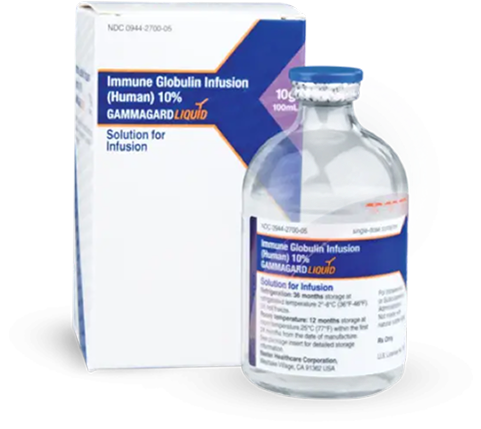GAMMAGARD LIQUID [Immune Globulin Infusion (Human)] 10% Solution is indicated as a replacement therapy for primary humoral immunodeficiency (PI) in adult and pediatric patients ≥2 years.
Dosing & Infusion Rates for PI
PI=primary immunodeficiency.

Intravenous immune globulin (IVIG) administration and a subcutaneous IG (SCIG) option are available for patients with PI
When starting a patient on treatment with GAMMAGARD LIQUID, the correct dose and rate of administration are based on the treatment indication and the individual patient’s weight.1
BW=body weight.
Adjust dose according to IgG levels and clinical response, as the frequency and dose of IG may vary from patient to patient.
| IV Administration | SC Administration | |
|---|---|---|
| Dose | 300 to 600 mg/kg every 3 to 4 weeks based on clinical response |
Initial dose is 1.37 x previous IV dose divided by number of weeks between IV doses
Maintenance dose is based on clinical response and target IgG trough level |
| Initial Rate of Infusion | 0.5 mL/kg/hr (0.8 mg/kg/min) for 30 minutes | 40 kg BW and greater: 30 mL/site at 20 mL/hr/site
Under 40 kg BW: 20 mL/site at 15 mL/hr/site |
| Maintenance Infusion Rate | Increase every 30 minutes (if tolerated) up to 5 mL/kg/hr (8 mg/kg/min) | 40 kg BW and greater: 30 mL/site at 20 to 30 mL/hr/site
Under 40 kg BW: 20 mL/site at 15 to 20 mL/hr/site |

IVIG dosing for PI1
Increase every 30 minutes (if tolerated) up to 5 mL/kg/hr (8 mg/kg/min)
- Initial infusion rate is 0.5 mL/kg/hr for 30 minutes
- It is important to individualize rates for each patient based on clinical response and tolerability
- Patients beginning treatment or switching from one IVIG product to another should be started at the lower infusion rates, and rates should be gradually increased as tolerated
Dosing calculator
Dosing range | Calculated infusion rates†
300 to 600 mg/kg (0.3 to 0.6 g/kg) every 3 or 4 weeks based on clinical response
| Min(g) | Max(g) |
|---|---|
| 3 | 6 |
| Time | mL/hr |
| 0-0.5 hr (mL/hr) | 5 |
| 0.5-1 hr (mL/hr) | 10 |
| 1-1.5 hr (mL/hr) | 20 |
| 1.5-2 hr (mL/hr) | 30 |
| 2-2.5 hr (mL/hr) | 40 |
| 2.5 hr - end of infusion (mL/hr) | 50 |
Healthcare professionals should determine the appropriate dose for each patient
based on patient examination, characteristics, and medical judgment.
*Weights have been rounded to the nearest pound; calculations based on this have also been rounded.
†GAMMAGARD LIQUID IV maintenance infusion rate may be increased every 30 minutes based on patient tolerability.
SCIG dose and infusion rates for PI
Prior to switching patients from GAMMAGARD LIQUID IVIG to SCIG, obtain the serum IgG trough level to guide subsequent dosing. To calculate the target trough IG level for SCIG treatment, add 281 mg/dL to the IG trough level obtained after the last IV treatment. Start the initial SCIG dose approximately 1 week after the last IVIG infusion.1
To guide dose adjustment, calculate the difference between the patient’s target serum IgG trough level and the actual IgG trough level during SCIG treatment1:
Change in weekly dose of GAMMAGARD LIQUID for intended IgG trough level adjustment1a
Difference between measured and target IgG trough levels
| Body Weight | 100 mg/dL | 200 mg/dL | 300 mg/dL | 400 mg/dL |
|---|---|---|---|---|
| 10 kg | 2 mL | 4 mL | 6 mL | 8 mL |
| 20 kg | 4 mL | 8 mL | 11 mL | 15 mL |
| 30 kg | 6 mL | 11 mL | 17 mL | 23 mL |
| 40 kg | 8 mL | 15 mL | 23 mL | 30 mL |
| 50 kg | 9 mL | 19 mL | 28 mL | 38 mL |
| 60 kg | 11 mL | 23 mL | 34 mL | 45 mL |
| 70 kg | 13 mL | 26 mL | 40 mL | 53 mL |
| 80 kg | 15 mL | 30 mL | 45 mL | 60 mL |
| 90 kg | 17 mL | 34 mL | 51 mL | 68 mL |
| 100 kg | 19 mL | 38 mL | 57 mL | 75 mL |
| 110 kg | 21 mL | 42 mL | 62 mL | 83 mL |
| 120 kg | 23 mL | 45 mL | 68 mL | 91 mL |
| 130 kg | 25 mL | 49 mL | 74 mL | 98 mL |
| 140 kg | 26 mL | 53 mL | 79 mL | 106 mL |
aDerived using a linear approximation to the nomogram method with a slope of 5.3 kg/dL.
Additional considerations
Ensure patients with preexisting renal insufficiency are not volume depleted; discontinue GAMMAGARD LIQUID if renal function deteriorates.1
For patients over 65 years of age or judged to be at risk for renal dysfunction or thrombotic events, administer GAMMAGARD LIQUID at the minimum infusion rate practicable.1
Review safety information
Review Important Safety Information, including Contraindications and other specific Warnings and Precautions to consider when prescribing and monitoring patients treated with GAMMAGARD LIQUID.
For patients with PI, GAMMAGARD LIQUID IV is given by a healthcare professional. It can be administered at1:
- A patient’s home
- A physician’s office
- A hospital
- An infusion center
SC administration may be given by the patient or a caregiver, after they’ve been properly trained by a healthcare professional.
Choosing an appropriate therapy
Takeda has a broad portfolio of IG therapies designed with different patient needs in mind. Discover another treatment option.2
SubQ IG with flexible
infusion options
Once-a-month† subQ IG
infusion
IG=immune globulin; subQ=subcutaneous.
†Every 3 or 4 weeks.
References:
- GAMMAGARD LIQUID. Prescribing Information. Takeda Pharmaceuticals U.S.A., Inc.; 2024.
- Marketing Research Bureau. The Plasma Proteins Market in the United States (based on aggregated data) – 2005-2022.